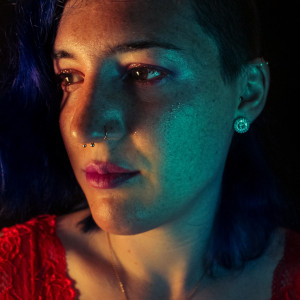Véronique Girard
Bachelor’s student in digital music

A get-together with Véronique Girard, bachelor’s student in digital music at the Université de Montréal Faculty of Music
- Could you talk to us about your academic career?
After getting a degree in fine arts and film animation, I took a big leap into music studies. This was new for me: my first sessions were fantastic! After taking a look at a number of programs, I finally fell for the bachelor’s in digital music.
- Why choose the bachelor’s in digital music at the Faculty of Music?
In my music training I discovered an open environment where every person is guided according to his or her preferences. I wanted to feel that I would have a place, even if I changed mediums.
In digital music, all students have a curriculum particular to themselves, and that’s what enriches the program enormously, creating an incredible community of sharing and mutual assistance.
- What do you like best about the Faculty?
The way the programs are designed allows many students with varied ‒ sometimes less conventional ‒ curricula to gain access to university studies in music. I have a huge appreciation for the support offered by the Faculty of Music and the Association étudiante de musique (Student Music Association: AÉMUM) to people who want to set up projects and student initiatives. So far I’ve been able to do things that I’m very proud of, particularly with the Cercle de composition (Composition Circle: CeCo).
- Thinking about your encounters with Faculty teachers, has there been one that was particularly inspiring?
My first “project class” (the term for composition and sound creation classes in digital music) with Ana Dall’Ara Majek ‒ and despite the pandemic that turned the winter 2020 semester on its head ‒ was one of the most memorable experiences of my academic career. Her way of being and working is enormously inspiring to me. She was able to take the little cloud of chaos that I was and offer me the support and tools I needed to move forward. She’s an accessible professor who knows just the right words to encourage us to carry on. Today I apply a lot of the things she conveyed to me, and I’m grateful to her for that.
- At the Faculty, have you learned anything the existence or usefulness of which you wouldn’t have suspected before?
It may seem a little strange, because the first thing I think of doesn't really have to do with the academic side of things but more with me personally, I learned that my individuality has value, and that my curriculum is what defined me as an artist. What I thought were shortcomings turned out to be what apened the most doors for me.
- Describe an ambitious (or completely wacky) project you’ve worked on.
Last spring I got an introductory research grant from OICRM, which made it possible for me to work on a project close to my heart: developing a somatic approach in teaching music creation. I worked out teaching-learning activities that make it possible for children (and adults too!) to familiarize themselves with processes and concepts associated with sound creation and electroacoustic composition.
I was very happy to make this idea ‒ one that I’d been thinking about for a long time ‒ a reality, transmitting electroacoustic music through movements of the body. It’s definitely something I hope to pursue in the future.
- Who’s your favorite artist and why?
Claire Renard, a French composer and multimedia artist, who studied electroacoustic composition with Pierre Schaeffer. What I find especially noteworthy about her is her research in education about creation in the learning of music. Her work is colored with the idea of transmitting curiosity and a sense of wonder to people learning music, and that’s one of my goals, too. She creates musical games in which each person can develop a musical language without feeling the obligation of conforming to a mold. It’s a vision that I share and that I also integrate into my practice.
- What are your aspirations?
Music for me embodies an opening to creation. In my work, what I try to do is establish and maintain open, stimulating, productive and inclusive environments. I find it crucial that every person be given the possibility for his or her creative drive to emerge, whatever that person’s credentials or level of expertise. Accessibility to art should not be a question of privilege, and that’s what I have in mind when I shape my work. For the future I hope to spread the change that I’d like to see around me. I want to be the model that I wish I’d had when I was starting out so that I can, I hope, inspire other people to do likewise.
February 2021